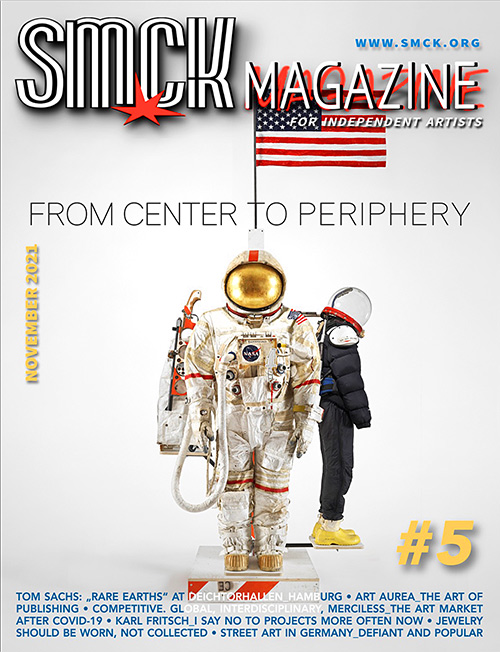JEWELRY SHOULD BE WORN, NOT COLLECTED
JEWELRY CONNOISSEUR JEROEN REDEL ON THE MEDIUM'S CHARMS AND RULES.
Interview by Christoph Ziegler
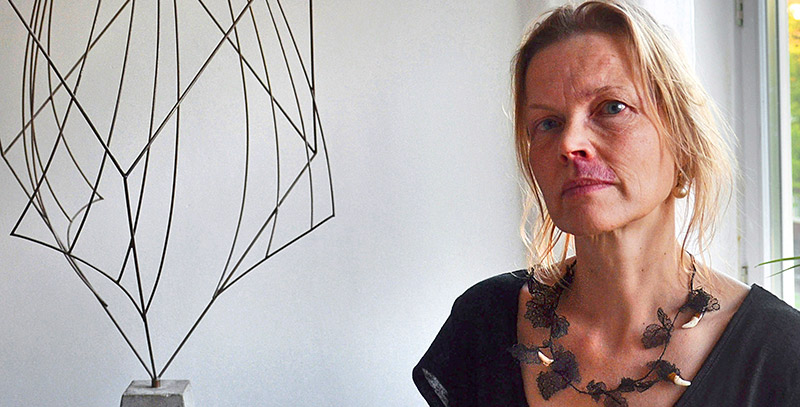 Sara Visbeek with necklace by Lisa Walker. Photo: J. Redel.
Sara Visbeek with necklace by Lisa Walker. Photo: J. Redel.
CZ: How did the Netherlands become one of the most important centers for contemporary jewelry?
JR: During the Seventies and Eighties, Amsterdam was the place to be. The atmosphere was very free and open-minded. You could get a grant here for doing things that weren't even allowed anywhere else. Art education at the Rietveld Academy was good and inexpensive. We had some very good, brave, and daring gallerists who broke a lot of boundaries and we had a good crowd of young professionals, architects, graphic designers, art critics, and artists who occasionally bought and regularly wore a new and interesting kind of jewelry.
What may have played a part is the fact that this new kind of jewelry had just 'liberated' itself from the realm of precious metals.
The new contemporary jewelry made of plastic bands, cardboard, or old bicycle tubes was quite affordable for a young public. At the time we (finally) discovered the world of contemporary jewelry in the late Nineties, this whole infrastructure - comprising good galleries, a functioning system of subsidies, grants and allowances, vibrant museum exhibitions, good art schools, good critics and writers - was still in place.
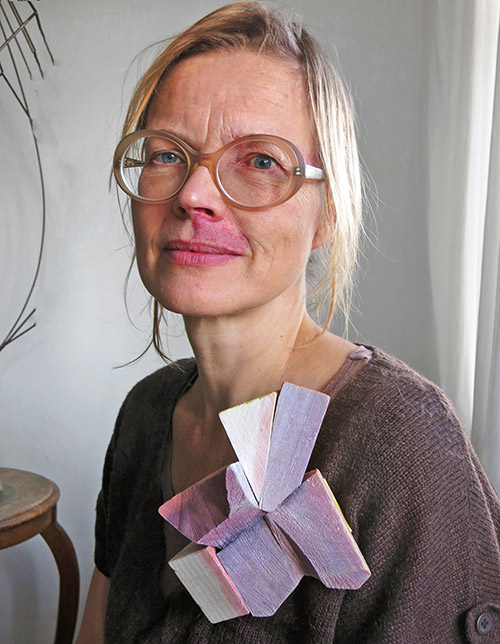
Sara Visbeek with brooch by Julia Walter. Photo: J. Redel.
Collecting jewelry
CZ: What makes contemporary jewelry so attractive to you?
JR: It started with me looking for jewelry for my wife Sara to wear, as a kind of adornment, as a gift, probably the way most people buy jewelry for a loved one.
I always found most pieces of jewelry very similar and boring. Then we finally discovered the hidden world of contemporary jewelry - jewelry that was not only enticing, beautiful, well-made, but also daring, bold, architectural, sculptural, concise, imaginative and, above all, meaningful, often in complicated ways.
Meaningful jewelry can interact with the individual wearer in very subtle and interesting ways. Sara finds wearing interesting pieces both inspiring and liberating. And I enjoy watching her wearing them. Some pieces excite, some protect, some warn others off, some attract, some abhor, some just make people wonder. Just as land art can't exist without a site as a situational context, so jewelry needs a wearer and a public to fully convey its meaning.
CZ: What does 'collecting' mean to you?
JR: The word ‘collecting' to me is connected to hoarding, to greed, to a silly pursuit of completeness and a desire for domination or control within a limited domain. Moreover, living in a hypercapitalist society, we are continuously stimulated to “express ourselves” as individuals by the things we buy. In this view one's personality and status are defined by one's taste and consumption; emo ergo sum: I buy, therefore I exist. These cultural and ethical considerations already argue quite strongly against collecting – but there is more.
Collecting comes with quite a few burdens. Buying good pieces involves making big financial sacrifices and it leaves one with a huge responsibility. Taking good care of important and valuable pieces of art from one generation to the next is difficult enough for a museum nowadays, let alone for a private individual.
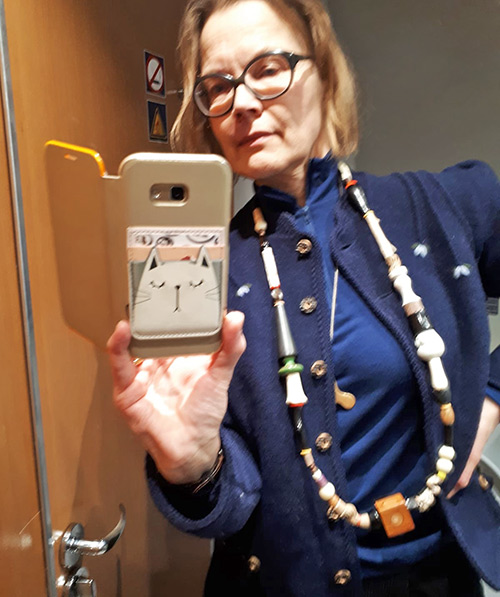
Sara Visbeek with necklace by Christoph Ziegler. Photo: Selfie.
Furthermore, if something is collected it is withdrawn from its original use. In the case of contemporary jewelry, probably the majority of pieces are collected and many never get worn at all. They are showcased in a gallery, purchased by collectors, stored in drawers or cabinets, and then bequeathed to a museum where they will be kept under lock and key. These pieces are deprived of a very important part of their meaning, in every sense of the word. Jewelry should be worn, not collected.
It's not strange that contemporary jewelry is collected as objects of art, but the fact that these pieces are not only art but also objects of craft which, sui generis, presuppose the act of wearing and which engage in a relationship with the wearer and relate to both the owner's body and mind, complicates matters a lot.
Without any wearer, contemporary jewelry is very difficult to display. Displayed behind glass, jewelry to me looks dead and buried. And maybe, just maybe, it's not only the wearing but also the ownership which is important for a piece of jewelry to fulfill its role since private ownership, value, and preciousness always have been, and still are, important aspects of what it is that defines jewelry as what it is.
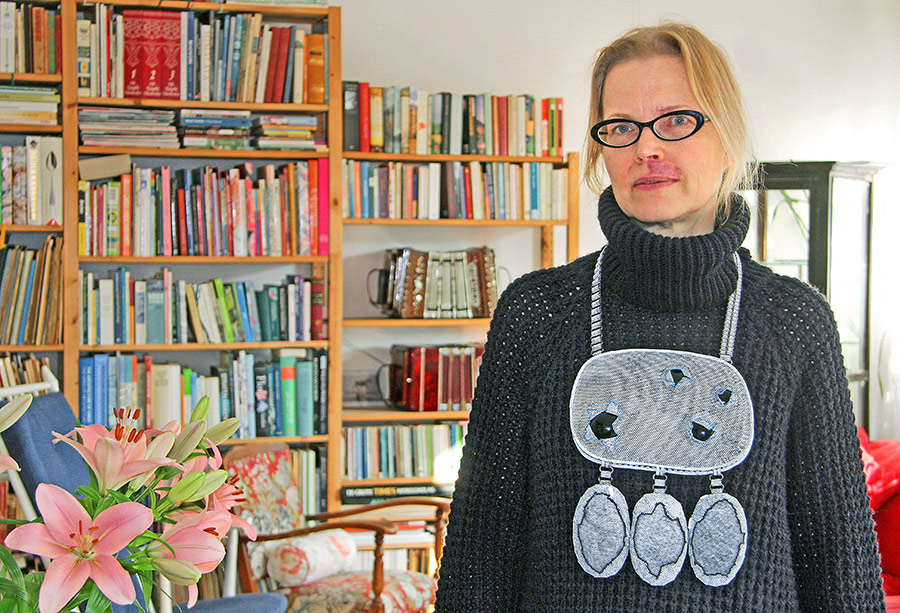 Sara Visbeek with pectoral by Dana Hakim. Photo: J. Redel.
Sara Visbeek with pectoral by Dana Hakim. Photo: J. Redel.
Value for money
CZ: Does future financial profit play a role in investing in contemporary jewelry?
JR: The market for contemporary jewelry is small. It's difficult enough for professional galleries to find a market and make a living.
The galleries generally take 50 per cent of the sale price so the moment you would try to sell a piece that you bought from a gallery to a professional buyer again, you are faced with at least a 50 per cent loss to start with. Furthermore, there is still no serious market for contemporary jewelry made 20 or 30 years ago. Maybe it will come one day, but have people said it would for as long as I can remember.
In comparison to the field of fine arts, prices in contemporary jewelry are fairly low; you're able to buy an absolute masterpiece for a few thousand euros. In that respect, contemporary jewelry can give you good value for money. But what is the financial value of a piece when no one is buying? In that case: zero. At the same time, I think it's quite sad that so very few artists in the field of jewelry are able to make a living by just making art.
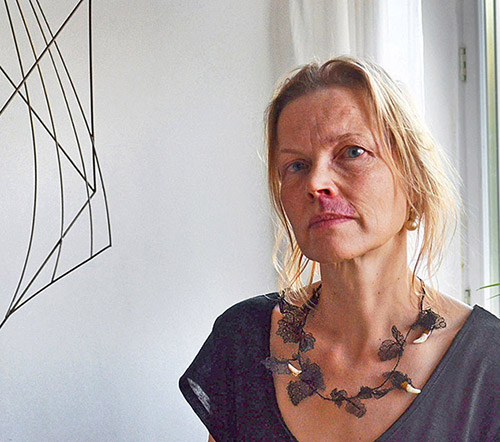
Sara Visbeek with necklace by Babette Boucher. Photo: J. Redel.
CZ: How can we get the broader public interested in contemporary jewelry?
JR: My inkling is that the gap between everyday jewelry and the work sold in the high-brow galleries has become too big over the last two decades. Understandably, not many people are willing and able to take the step from buying cheap, meaningless jewelry to buying very expensive pieces which are often difficult to wear in almost every respect. I think we need to bridge that gap and improve the wearability of contemporary jewelry.
Do you want your work to live and be worn?
CZ: What do you advise young artists and designers?
JR: Think about the wearability and affordability of your work. Many young artists seem to think that because the jewelry they make is art, or supposed to be art, it doesn't need to be wearable anymore. If jewelry isn't wearable, it starts to lose its raison d'etre: it loses its meaning, its relationship to the body and the wearer, and it defies its purpose.
Sometimes conceptual demands can override the demands of wearability, but never can poor craftmanship be a valid excuse for any lack of wearability. Art and craft should, and can, go hand in hand.
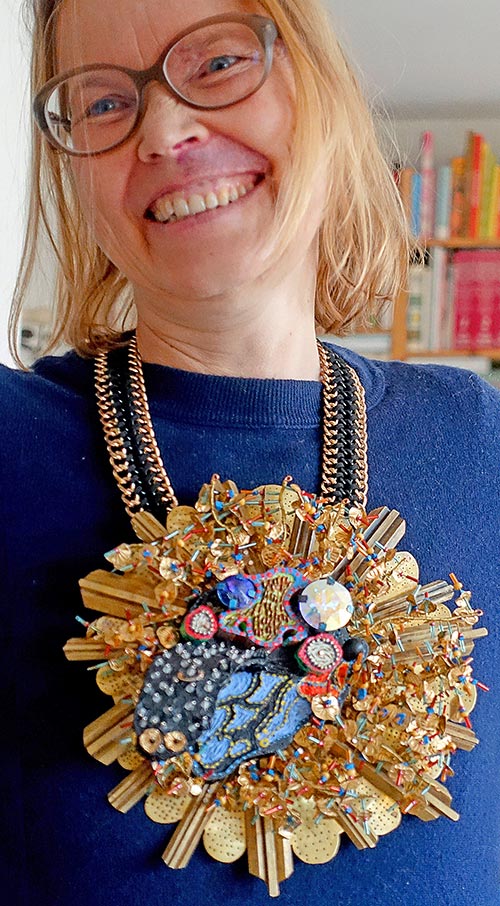
Sara Visbeek with necklace by Coco Sung. Photo: J. Redel.
How does a piece sit on the body? Does it twist or break or stain easily? Can it get wet? Is one able to wear a coat on top of it?
It's not enough for a piece to look good in a photo. Tangibility, touch, weight, and balance are just as important.
Affordability is closely related to wearability. If, as an artist, you only aim for high-end buyers, there's a good chance your work will never be sold at all and if it is, it will likely never get worn. Do you want your work to end up buried in a museum drawer or to live and be worn and shared in public – or both?
Nothing is wrong with making affordable multiples, provided buyers are made aware of the fact that they are buying a multiple. Be open about the number of copies you intend to make. If your gallerist tells you otherwise, ignore them. If they say they only want exclusive pieces and you disagree, gather some fellow makers and start your own gallery.
LINKS:
www.redel-tuin.nl |
www.thepooljewelry.com









